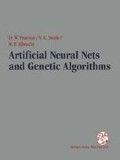Abstract
In this work we have combined two promising global optimization methods, interval arithmetic methods and genetic algorithms, into a set of hybrid algorithms that share the good properties of both methods while avoiding some drawbacks of the constituent methods. Interval aritmetic gives us some simple arithmetic methods to estimate the range of rational functions to be optimized, while genetic algorithms are able to adaptively guide the search.
Access this chapter
Tax calculation will be finalised at checkout
Purchases are for personal use only
Preview
Unable to display preview. Download preview PDF.
References
Reiner Horst and Hoang Tuy. Global Optimization. Springer-Verlag, Berlin, 1990.
R. E. Moore. Interval Analysis. Prentice-Hall, Inc., Englewood Cliffs, 1966.
Jon Rokne and T. Wu. The circular complex centered form. Computing, 28: 17–30, 1982.
Jon Rokne and T. Wu. A note on the circular complex centered form. Computing, 30: 201–211, 1983.
Jarmo T. Alander. An indexed bibliography of genetic algorithms: Years 1957–1993. Art of CAD Ltd., Vaasa (Finland), 1994. (over 3000 GA references).
T. M. Murdock, W. E. Schmitendorf, and Stephanie Forrest. Use of genetic algorithm to analyze robust stability problems. In Proceedings of the. American Automatic Control Conference, pages 886–889, Boston, MA, 26.–28. June 1991. American Automatic Control Council.
Marco Muselli and Sandro Ridella. Global optimization of functions with the interval genetic algorithm. Complex Systems, 6 (3): 193–212, June 1992.
Larry J. Eshelman and J. David Schaffer. Real-coded genetic algorithms and interval-schemata. In Whitley [22], pages 187–202.
Kwong Sak Leung, Yee Leung, Leo So, and Kim Fai Yam. Rule learning in expert systems using genetic algorithm: 1, concepts. In Proceedings of the 2nd International Conference on Fuzzy Logic and Neural Networks (IIZUKA’92), volume 1, pages 201–204, Iizuka (Japan), 17.–22. July 1992. Fuzzy Logic Systems Institute.
Kwong Sak Leung, Yee Leung, Leo So, and Kim Fai Yam. Rule learning in expert systems using genetic algorithm: 1, empirical studies. In Proceedings of the 2nd International Conference on Fuzzy Logic and Neural Networks (IIZUKA’92), volume 1, pages 205–208, Iizuka (Japan), 17.–22. July 1992. Fuzzy Logic Systems Institute.
Peng Tian and Zihou Yang. An improved simulated annealing algorithm with genetic characteristics and the traveling salesman problem. J. Inf. Optimization Sci. (India), 14 (3): 241–255, September 1993.
R. E. Moore. Methods and Applications of Interval Analysis. SIAM, Philadelphia, 1979.
W. Chuba and W. Miller. Quadratic convergence in interval arithmetic. Part I. BIT, 12: 284–290, 1972.
Jarmo T. Alander. On interval arithmetic range approximation methods of polynomials and rational functions. Computersamp;Graphics, 9 (4): 365–372, 1985.
H. Ratschek. Centered forms. SIAM Journal of Numerical Analysis, 17: 656–662, 1980.
E. R. Hansen. Global optimization using interval analysis — the one-dimensional case. J. Optim. Theory and Appl., 29: 331–344, 1979.
E. R. Hansen. Global optimization using interval analysis — the multidimensional case. Numerische Matematik, 34: 247–270, 1980.
Helmut Ratschek and Jon Rokne. New computer methods for global optimization. Ellis Horwood, New York, 1988.
Jarmo T. Alander. Programmers manual of interval package IP++, Version 0.0 and comparison to IP. Technical Report HTKK-TKO-B62, Helsinki University of Technology, Laboratory of Information Processing Science, 1987.
Jarmo T. Alander. On robot navigation using a genetic algorithm. In R. F. Albrecht, C. R. Reeves, and N. C. Steele, editors, Artificial Neural Nets and Genetic Algorithms, pages 471–478, Innsbruck, Austria, 13.–16. April 1993. Springer-Verlag, Wien.
Jarmo T. Alander. Some new global optimization algorithms using genetic algorithms and interval arithmetics. Technical Report 95-1, University of Vaasa, Department of Information Technology and Industrial Management, Vaasa (Finland), 1995. (to appear; anonymous ftp site ftp.uwasa.fi directory cs file report95-1.ps.Z).
Darrell Whitley, editor. Foundations of Genetic Algorithms — 2 (FOGA-92), Vail, CO, 24.–29. July 1992 1993. Morgan Kaufmann: San Mateo, CA.
Author information
Authors and Affiliations
Rights and permissions
Copyright information
© 1995 Springer-Verlag/Wien
About this paper
Cite this paper
Alander, J.T. (1995). Interval arithmetic and genetic algorithms in global optimization. In: Artificial Neural Nets and Genetic Algorithms. Springer, Vienna. https://doi.org/10.1007/978-3-7091-7535-4_101
Download citation
DOI: https://doi.org/10.1007/978-3-7091-7535-4_101
Publisher Name: Springer, Vienna
Print ISBN: 978-3-211-82692-8
Online ISBN: 978-3-7091-7535-4
eBook Packages: Springer Book Archive

